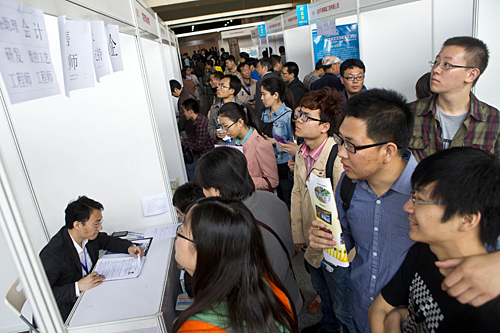|
 |
|
JOINT RECRUITMENT: A talent exchange fair for the Jing-Jin-Ji region is held at China International Science and Technology Convention Center in Beijing on April 23 (ZHAO BING) |
After being laid aside for a decade, the Jing-Jin-Ji development plan, which proposes fusing the areas of Beijing, Tianjin and Hebei Province, has resurfaced under the new moniker of the Capital Economic Circle. In February, President Xi Jinping called for the coordination and integration of the economic zone surrounding Beijing, and noted the need for balancing development, the environment, population and resources, thus signaling that planning will be officially being put on the fast track.
The planned area encompasses Beijing, Tianjin and part of Hebei Province in north China, a cluster inhabited by over 100 million people, three times as many as that of the Tokyo Megalopolis. The area boasts a combined GDP of over 6 trillion yuan ($980 billion) and covers an area of 216,000 square km.
The economic circle represents an answer to the "urban diseases" currently afflicting Beijing, such as traffic jams and air pollution. With a population of more than 20 million, the city is the political, economic and cultural center of China. Furthermore, it has the largest number of famous universities, well-established hospitals and the largest hi-tech industrial center.
"Beijing should stop trying to be the champion in every aspect, and transfer some resources to its neighbors," said Yang Weimin, deputy head of the Office of the Central Leading Group on Finance and Economic Affairs, which is affiliated to the Communist Party of China Central Committee.
As President Xi pointed out, Beijing ought to retain its status as the political, cultural and diplomacy hub of China, and at the same time, move some non-essential industrial sectors like high-polluting manufacturing outside the city gradually. Beyond that, the excessive concentration of financial, medical and education resources should also be alleviated. For example, every year, numerous people flock to Beijing for better medical treatment, which adds to the pressure on the city's traffic management and social security systems.
Distinctions
The integration of the Jing-Jin-Ji region has been deemed as the first economic circle in north China, and the third engine to drive economic growth following on the heels of the Pearl River Delta and the Yangtze River Delta, in south and east China respectively.
Compared to the Yangtze River Delta and the Pearl River Delta, the Jing-Jin-Ji urban agglomeration is less open to the outside world. In 2012, export accounted for 15.12 percent of its gross domestic product (GDP), much lower than the 60.44 percent in the Yangtze River Delta and the 63.37 percent in the Pearl River Delta.
The industrial cluster in the Pearl River Delta took shape in response to the country's call for reform and opening up during the 1980s, while the Yangtze River Delta began to mold its own industrial structure in the 1990s, when local governments were assigned with more power and became increasingly connected to the market. The formation of the Jing-Jin-Ji urban agglomeration has been largely fueled by government planning with strong administrative monopoly.
Li Tie, Director General of the China Center for Urban Development of the National Development and Reform Commission, claimed the economic circle was uniquely threatened by a number of factors.
Hebei Province cannot match Beijing and Tianjin and is at a relatively disadvantageous place in terms of administrative rank. In addition, in coordinating the development of the Jing-Jin-Ji region, proposals akin to the Bohai Economic Rim have been put forward to ensure the pivotal position of Beijing in the process, further exacerbating the imbalances in allocating resources and opportunities.
| 